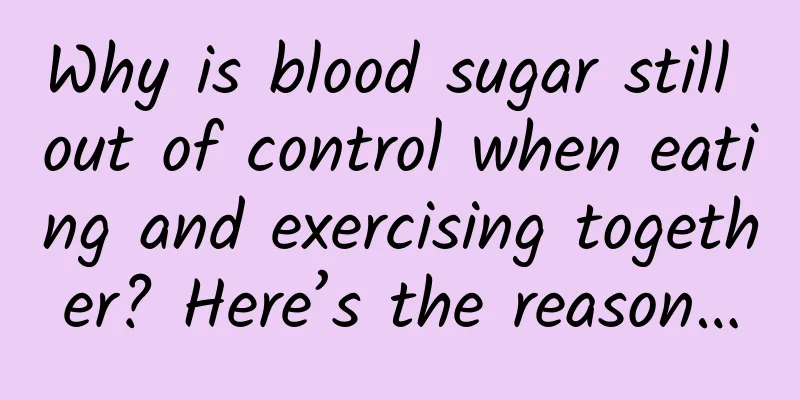Why is blood sugar still out of control when eating and exercising together? Here’s the reason…

|
Diabetes has become widely known for its characteristics of increasingly younger age of onset, long course of disease, multiple complications, serious health hazards and high medical expenses, especially its typical symptoms of three mores and one less, namely, drinking more, eating more, urinating more and weight loss. The risk factors for diabetes are mostly related to unreasonable eating habits, including long-term high-sugar, high-fat, and high-energy diets. Correcting unhealthy lifestyles, practicing a reasonable diet and active exercise have always been effective means to prevent and control the occurrence and development of diabetes. However, many diabetics always ask in confusion: "I have controlled my diet and exercised, but why can't my blood sugar go down?" So ask yourself: "Are your food choices, meal order, exercise methods, exercise timing, etc. correct?" 1. There are some rules for eating a sugar-controlled diet ①How to choose food? It is recommended to diversify food choices, and the daily diet should include cereals, potatoes, vegetables, fruits, livestock, poultry, fish, eggs, milk, and beans, etc. It is recommended to consume an average of more than 12 kinds of food per day and more than 25 kinds per week. Because the more monotonous the food, the faster your blood sugar will rise. Note that you should eat more types of food every day, but not too much. Therefore, staple foods should be quantitative, not too much, and learn to match coarse and fine foods. Choose more whole grains and low GI (food glycemic index) foods; low GI foods such as whole grains and beans should account for more than 1/3 of the staple food. It should be noted that if low GI foods are eaten too much, they will also increase the blood sugar burden after meals, while high GI foods are not completely restricted. Eating less and matching them properly can also help maintain blood sugar homeostasis. ▶ Eat less high GI (GI>70) foods: rice, glutinous rice, instant rice, instant rice porridge, white flour steamed buns, pancakes, rice cakes, white bread, soda crackers, puffed crackers, mashed potatoes, sweet potatoes (boiled), pumpkin, watermelon, etc. ▶Don’t eat too much medium GI (55<GI≤70) food: brown rice, whole wheat noodles, soybean noodles, buckwheat noodles, cornmeal, Indian burritos, pizza (containing cheese), whole wheat bread, barley bread, oatmeal bread, wheat biscuits, crispy biscuits, potatoes (boiled, steamed, baked), potato chips (fried), beets, pineapple, cantaloupe, canned fruits (such as peaches, apricots), etc. ▶ Choose low GI (GI ≤ 55) foods in moderation: wheat, barley, rye, buckwheat, black rice, oatmeal, oats, highland barley, corn, oat bran, durum wheat noodles, macaroni, spaghetti, udon noodles, tortillas, rye grain bread, yam, taro (steamed), potato vermicelli, lotus root starch, soybeans, black beans, green beans, mung beans, broad beans, chickpeas, kidney beans, tofu, dried tofu, asparagus, cauliflower, broccoli, celery, cucumber, eggplant, lettuce, green pepper, tomato, spinach, apples, pears, peaches, plums, cherries, grapes, kiwi, citrus, mango, plantain, banana, strawberry, milk, yogurt, peanuts, cashews, etc. ② The arrangement and order of meals are important At least three meals a day, according to Xinjiang's work and rest time, try to finish breakfast before 10:00, and dinner before 20:00. Those who are prone to hypoglycemia after injecting insulin or taking oral hypoglycemic drugs should have extra meals, and the amount of extra meals should be deducted from the total amount of the main meal, so that the extra meals do not increase the amount. Maintaining an optimistic attitude and a regular work and rest schedule are conducive to stabilizing blood sugar. For those with high blood sugar, it is recommended to pay attention to the order of eating. The first ten bites should only eat vegetables and meat. From the eleventh bite, one bite of staple food and one bite of meat and vegetable. The amount of vegetables for each meal should be at least ≥ the amount of staple food. The daily vegetable amount is recommended to be 500g, of which dark vegetables account for more than half. The amount of fruit you eat should be limited, and you should try to eat it as a snack during the day when you are not hungry. It is not recommended to eat it before going to bed or when you are hungry. ③Eating speed also affects blood sugar A researcher once conducted an experiment on a person who used to eat very fast: they installed a dynamic blood glucose meter on him before meals to monitor the changes in blood sugar during meals when he ate fast and slowly. The food, weight, and pre-meal blood sugar were all the same. The results are shown in the figure above. Before eating, his blood sugar level was 5.5mmol/l. According to the frequency of chewing a mouthful of rice 4 times and swallowing, he finished a meal in 5 minutes. After eating quickly, his blood sugar level rose rapidly, and the highest rose to 11mmol/l! When a mouthful of rice is chewed (28 times) and finished in 30 minutes, we can see that during the whole eating process, his blood sugar level is steadily rising, and the highest is only 7.2mmol/l. By slowing down your eating speed, not only can your blood sugar level drop, but you can also eat less. Because when our body senses an increase in blood sugar levels, the "satiety center" will start to work, which can suppress appetite. But if you want your body's "satiety center" to start working, you need to wait at least 15 minutes (after you start eating). If you eat too fast, the "satiety center" won't have time to "work", and you'll end up eating too much! Therefore, it is recommended that each meal last 20-30 minutes. ④Cooking method is very important It is mostly cooked by stewing, steaming, braising, roasting, sautéing, and stir-frying to ensure the integrity of nutrients. Be cautious when eating fried, smoked, and grilled foods, as too much oil and salt can also affect blood sugar. Sweet corn or glutinous corn, which one raises blood sugar faster? Glutinous corn! The reason is that glutinous corn contains a lot of amylopectin. Amylopectin contains a lot of glucose molecules in a branch-like structure, and the connections are loose. Each glucose molecule can be well exposed to the action of digestive enzymes and digested into the blood quickly. Studies have found that rice cakes containing a lot of amylopectin have a higher glycemic index than eating glucose directly. Data shows that the glycemic index (GI) of boiled sweet potatoes is 77, while the GI of baked sweet potatoes soars to 94, close to glucose (100). This is because part of the sucrose is converted into maltose during the baking process, which raises blood sugar faster... 2. Reasonable exercise is important ①How to choose the exercise method? Aerobic exercise refers to continuous or intermittent exercise using large muscle groups, including brisk walking, jogging, table tennis, badminton, cycling, etc., among which brisk walking is the most widely recommended form of exercise. Tai Chi, Wu Qin Xi and Ba Duan Jin are the main forms of exercise prescribed by traditional Chinese medicine and are recommended as aerobic exercise in the "Guidelines for Exercise Treatment of Diabetes in China". Anaerobic exercise refers to resistance exercise that applies a certain amount of resistance to the body in some form to promote muscle mass and strength, generally including dumbbells, push-ups, machine-based exercises, etc. Both aerobic and anaerobic exercise can relieve patients' impaired glucose tolerance and impaired fasting blood sugar, enhance cardiovascular function, regulate the secretion function of pancreatic cells, improve metabolic abnormalities such as blood sugar, blood lipids and insulin resistance, and can also actively regulate the psychological and social functions of diabetic patients and improve their quality of life. You can choose 1-2 types of aerobic exercises combined with anaerobic exercises according to your own preferences to avoid the monotony and boredom of exercise and improve exercise compliance. ②How to choose exercise intensity? Follow the principles of "from less to more, from light to heavy, perseverance, do what you can, step by step, and moderate recovery", and moderate intensity exercise should account for more than 50%. Studies have shown that moderate-intensity physical exercise is the safest and most effective for patients with type 2 diabetes. The NICE guidelines propose a relatively simple method for estimating exercise intensity, which is to exercise with a little effort, increase heart rate and breathing but not too fast, feel warm, and be able to have a comfortable conversation. In daily exercise, the simple method proposed by the NICE guidelines can be used to evaluate the body's response to ensure exercise safety. ③How long is the appropriate amount of exercise? The reasonable exercise frequency is 3-7 times/week. The exercise frequency can be determined according to the amount of exercise. If the amount of exercise each time is small and the patient's body allows, it is sufficient to exercise once a day; if the amount of exercise each time is large, it can be separated by 1-2 days, but not more than 3 days. The duration of exercise can be adjusted appropriately according to the frequency of exercise. If the duration of exercise is less than 30 minutes, it is not conducive to improving cardiopulmonary function, and if the duration of exercise is more than 60 minutes, it will increase the probability of joint injury. Therefore, it is most appropriate to keep the duration of each exercise at 30-45 minutes (excluding the time for warm-up and stretching after the end). If physical condition, time and other conditions do not allow, it is also okay to exercise in batches. Movement is always better than no movement. ④When is the best time to exercise? Can I exercise immediately after a meal? Not recommended! Because exercising immediately after a meal is not only likely to cause gastrointestinal diseases, but also increases the secretion of hormones that antagonize insulin in the body, leading to a decrease in the effect of insulin, which will cause a transient increase in blood sugar after a meal. In addition, it is not recommended to perform high-intensity exercise on an empty stomach, especially in the early morning, as this can easily lead to hypoglycemia, palpitations, cold sweats, pale complexion, dizziness, coma, shock, and even death. Studies have shown that doing moderate activities 0.5-1 hour after a meal is very beneficial for lowering blood sugar, because when blood sugar reaches its peak, proper exercise can increase the sensitivity of peripheral tissues, especially muscle tissue, to insulin. At the same time, it can promote muscle tissue to use glucose and reduce the output of liver glycogen, so as to achieve the effect of lowering blood sugar. Food is the first necessity of the people. Combining eating and moving is the core of blood sugar control for diabetic patients. They should strive to implement the daily diet recommendations in the "Diet Guide for Adults with Diabetes (2023 Edition)", follow the principle of balanced diet, and ensure that the food is diverse, the staple food is fixed, the vegetables, fruits, milk and beans are rich, and the oil, salt and sugar are low. While controlling blood sugar, ensure that the daily energy and nutrient intake are adequate. Pay attention to every detail and learn to eat and move correctly to better control blood sugar. Message: "I keep digging and digging on the road of sugar control. I only hope that you can grow flowers of victory in your sugar control garden." References: [1] Guidelines for the prevention and treatment of type 2 diabetes in China (2020 edition) (Volume 1)[J]. Chinese Journal of Practical Internal Medicine, 2021, 41(08): 668-695. Written by: Li Caihong, Chief Nutritionist of the Nutrition Department of the First People's Hospital of Urumqi, member of the Chinese Nutrition Society, and secretary of the Youth Committee of the Xinjiang Nutrition Society Reviewer: Chen Peipei, Executive Director of Xinjiang Nutrition Society, Deputy Director of Clinical Nutrition Department of the First Affiliated Hospital of Xinjiang Medical University, and Expert in Science Education for Xinjiang Youth Note: All pictures are from Baidu and clinical data hand-drawn |
>>: What? Why are satellites scheduled for morning and afternoon shifts?
Recommend
Play with short videos and learn how to create a profitable TikTok account from scratch!
Why do Tik Tok ? How to make Tik Tok? For enterpr...
Case Analysis: How I was "cheated" into buying a monthly membership for Daily Fresh
It is important to make users feel that the servi...
As panel manufacturers have turned losses into profits, are good days coming for TV companies?
Unlike the TV industry, which has been in deep tr...
Analysis of ICBC's competitive products!
With the continuous penetration of the Internet i...
After the age of 40, is it really the end of the road for programmers?
Is ageism a career problem in software developmen...
Do you know the three functions of coffee?
Can coffee promote digestion, increase beneficial...
5G RedCap: The key to continued IoT growth
Preface The first 5G New Radio (NR) network was l...
10 Taobao operation tips to increase your store’s popularity!
What are the Taobao operation skills? Sometimes T...
How many days of holidays will Guangxi have on March 3rd in 2022? How many days of vacation are there? Attached is the latest holiday schedule
The third day of the third lunar month every year...
A barely passed defense helped chemistry turn over the "darkest chapter"
German chemist Ostwald once lamented that the rel...
Deconstructing the universal formula for e-commerce operations!
E-commerce operation is the most special operatio...
We analyzed 100 mobile apps and found 6 common reasons why apps crash!
People hate app crashes, especially when they slo...
A Complete Guide to Business Analysis - Using Data Analysis to Solve Business Problems
A Complete Guide to Business Analysis - Using Dat...
Getting Swiss watches into trouble: Did Apple pick the wrong target?
As Apple's new product launch on September 9 ...
If your head itches, don't scratch it! Be careful of this skin disease, which will not only leave scars but also cause hair loss...
When you are bored, irritable, or have a hard tim...









